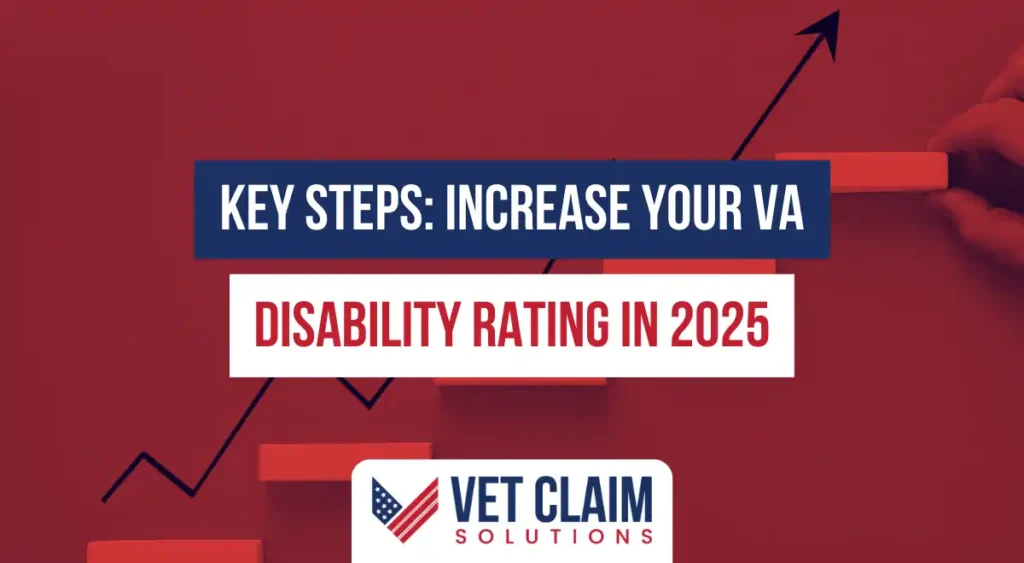Increasing your VA disability rating in 2025 can feel like a big challenge, but it is achievable. With the right approach, you can gather crucial evidence, file effectively for increases, and protect yourself from potential rating reductions. This guide explains how to boost your VA disability rating and secure the VA benefits and disability compensation you rightfully deserve.

Understanding VA Disability Ratings
Your VA disability rating is a percentage that reflects the severity of your service-connected disability condition. This rating directly determines the amount of monthly disability compensation you receive from the Department of Veterans Affairs. The higher your va rating, the more financial support and va benefit options become available to you.
Ratings range from 0% to 100%, typically assigned in 10% increments. A 0% rating acknowledges a service-connected condition but doesn’t provide monetary compensation, while a 100% rating provides the maximum scheduled monthly payment. Understanding your initial rating is the first step toward seeking an increase if your condition has worsened.
It’s important to grasp that the VA uses a specific method, often called “VA Math,” to calculate a combined rating when a veteran has multiple disability ratings. This means simply adding individual disability ratings together will not give you the final combined rating. Knowing how this system works helps you identify areas for potential rating increases and strategize for a higher va disability rating increase.
How the VA Combines Disability Ratings
The VA’s method for combining multiple disability ratings is designed to reflect the overall impact on your earning capacity, not a simple sum of parts. The VA starts with the idea that a veteran is 100% whole or efficient. Each disability rating then reduces that efficiency.
For example, if you have a 30% rating for one condition, the VA considers you 70% efficient. If you then have a second condition rated at 20%, the VA calculates 20% of the remaining 70% efficiency, which is 14%. This 14% is added to the initial 30%, resulting in a 44% rating, which would then be rounded to the nearest 10% (so 40%). Many veterans use an online ratings calculator to estimate their combined rating.
This system means that the higher your existing combined rating, the more difficult it becomes to achieve further significant increases with additional, lower-rated conditions. Focusing on increasing ratings for existing conditions or establishing secondary service connection for more severe conditions often yields better results for a disability rating increase. Understanding how to combine ratings effectively is a large part of the claims process.
Gather Strong Medical Evidence
Comprehensive medical evidence is the foundation of any successful va claim for an increased rating. Begin by maintaining regular medical appointments and consistent treatment for all your service-connected disabilities. This updated medical documentation is critical.
Keep meticulous medical records of every doctor’s visit, prescribed treatments, medication changes, and detailed notes on how your disabilities affect your daily life and ability to perform routine tasks. This ongoing record-keeping creates a strong evidential basis to support your increase request and show your condition worsened. Properly gathering evidence is vital.
One of the most powerful pieces of medical evidence can be a nexus letter. A nexus letter is a statement from a medical professional that explicitly links your current medical condition (or its worsening) to your military service or to another service-connected condition. This letter should be based on a review of your medical records and service history.
Supporting statements from family members, friends, or former colleagues, often called “buddy statements,” can also provide valuable context. These statements describe how your disabilities impact your daily activities, social interactions, and work capacity from a layperson’s perspective. When you collect evidence, include these personal accounts.

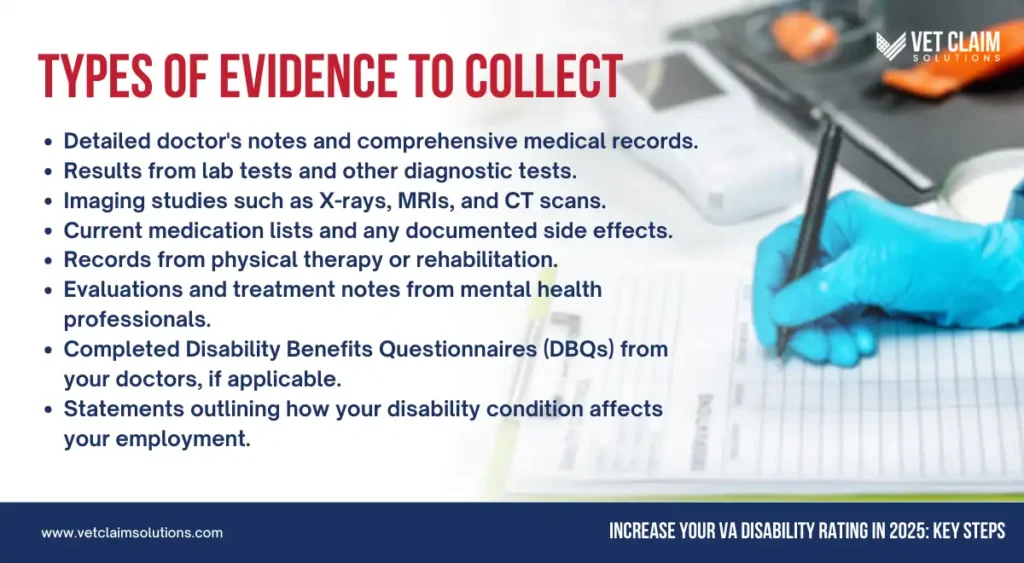
Do not forget to thoroughly document how your service-connected condition curtails your ability to work and impacts your personal life. This complete picture of your disability is crucial relevant evidence for the VA. Providing a clear link between your symptoms and their functional impact strengthens your disability claim.
File for Secondary Service Connection
Secondary service connection is a significant avenue for increasing your overall va disability rating. This applies to new disabilities that are caused or aggravated by an already service-connected disability condition. For example, if a service-connected knee injury causes you to walk with an altered gait, leading to back problems or hip issues, those subsequent problems may qualify for secondary service connection.
Carefully review your current health issues and consult with your doctor. You might be experiencing secondary conditions without realizing they could be linked to your existing service-connected disabilities. Establishing this link through medical evidence, including a potential nexus letter, is essential for a successful claim for these disability benefits.
The VA needs to see a clear medical link showing that the primary service-connected disability was at least a contributing factor in the development or worsening of the secondary disability. For example, sleep apnea can be secondary to PTSD, or depression can develop due to chronic pain from a service-connected injury. Identifying these connections can significantly help your va rating increase.
Common Secondary Conditions
- Depression or other mental health conditions secondary to chronic pain.
- Sleep apnea potentially aggravated or caused by PTSD or other respiratory issues.
- Radiculopathy (nerve pain) secondary to back injuries or spinal conditions.
- Hypertension secondary to conditions like PTSD or kidney disease.
- Gastroesophageal reflux disease (GERD) aggravated by medications for a service-connected condition.
Filing successful claims for secondary conditions can substantively boost your overall disability rating and monthly compensation. You must clearly demonstrate the connection between your direct service connected disability and the subsequent secondary conditions using medical evidence. This is a common path to a higher rating for many veterans.
Consider Individual Unemployability
Total Disability Based on Individual Unemployability (TDIU) is a vital provision for veterans whose service-connected disabilities prevent them from maintaining substantially gainful employment, even if their combined rating is less than 100%. If approved, TDIU allows veterans to receive va benefits at the 100% disability rate. This can lead to a significant increase in disability compensation.
To be eligible for TDIU under the schedular criteria, a veteran generally needs one service-connected disability rated at 60% or more. Alternatively, if a veteran has multiple service-connected disabilities, they must have at least one rated at 40% or more, with a combined rating of 70% or more. Veterans unable to work due to their disabilities should explore this option for total disability benefits.
Substantially gainful employment is generally defined as employment that is not marginal and pays above the poverty level for a single person. If your service-connected conditions prevent you from securing or holding a job that meets this definition, applying for TDIU is a logical step. You will need to complete VA Form 21-8940 (Veteran’s Application for Increased Compensation Based on Unemployability) and often VA Form 21-4192 (Request for Employment Information in Connection with Claim for Disability Benefits) as part of your TDIU claim.
The Importance of C&P Exams
Compensation & Pension (C&P) exams are medical examinations ordered by the VA to evaluate the current state of your claimed disability conditions. These exams are a critical part of the claims process for an increased rating, as the examiner’s report heavily influences the VA’s decision on your rating level. It is vital to attend all scheduled C&P exams.
Prepare for your C&P exam by reviewing your medical records and making notes about your symptoms, their frequency, severity, and how they impact your daily activities. Be honest and thorough with the examiner; do not exaggerate, but also do not downplay your symptoms or limitations. Clearly explain how your service-connected disability has worsened since your initial rating.
After the exam, you can request a copy of the C&P report from your regional office to understand the examiner’s findings. If the report seems inaccurate or incomplete, you can submit additional evidence or a statement to counter the findings. A well-documented C&P exam that accurately reflects your disability is important for a favorable outcome.

Presumptive Service Connection Explained
Presumptive service connection simplifies the process for certain veterans to obtain va disability benefits for specific conditions. If a veteran served in a particular location during a specific period and later develops a condition known to be associated with that service, the VA may presume the condition is service-connected. This means the veteran does not have to provide the same level of evidence linking their condition directly to an in-service event or injury for direct service connection.
Examples include veterans exposed to Agent Orange in Vietnam who develop conditions like diabetes mellitus type 2 or Parkinson’s disease. Similarly, Gulf War veterans with certain chronic multi-symptom illnesses may qualify for presumptive service connection. The PACT Act of 2022 significantly expanded presumptive conditions for veterans exposed to burn pits and other toxins, including various cancers and respiratory illnesses.
Understanding presumptive conditions can be very beneficial. If your condition qualifies as presumptive, it can streamline your disability claim and increase your chances of receiving VA benefits. Regularly check VA updates for any new presumptive conditions related to your service, as this can open doors for a new claim or an increased rating if an existing condition is now considered presumptive.
Stay on Top of Reevaluations
The VA may schedule reevaluations for your service-connected conditions, particularly if they are not considered permanent and total (P&T). These reviews are conducted to determine if your disability condition has improved, worsened, or stayed the same. A reevaluation can potentially lead to a rating reduction if the VA believes your condition has significantly improved.
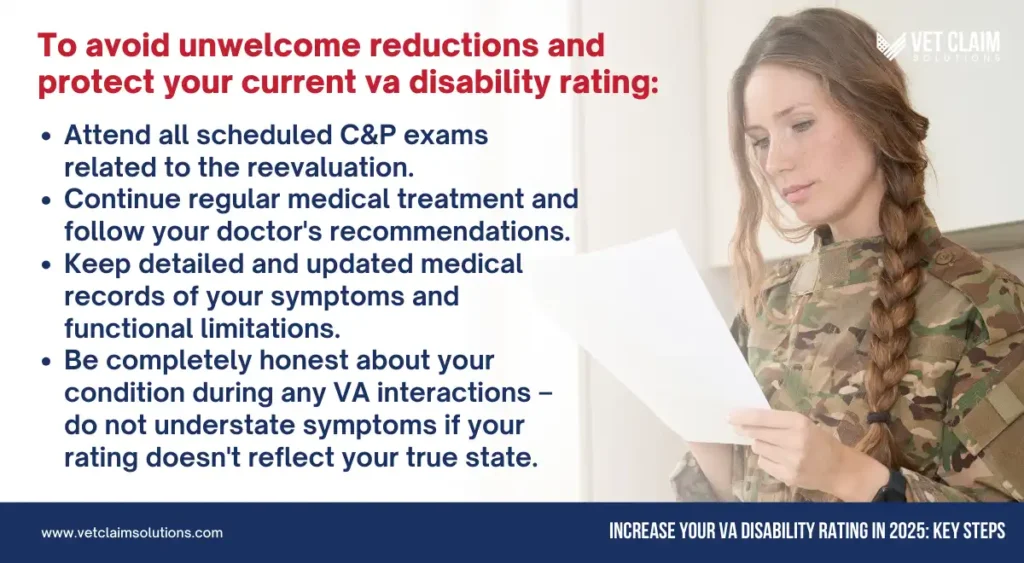
If you receive a notice from the VA proposing a reduction to your disability rating, you must respond promptly. You typically have 30 days to submit additional medical evidence supporting your current rating level and 60 days to request a hearing. Protecting your initial rating or a previously increased rating is just as important as seeking a new one.
Consider New and Material Evidence for a Supplemental Claim
If you have previously been denied an increased rating, you can reopen your disability claim by filing a supplemental claim with new and material evidence. “New” evidence is information the VA has not previously considered. “Material” evidence is relevant to your claim and has the potential to change the VA’s previous decision.
Examples of new and material relevant evidence for a rating increase request include:
- Recent medical records documenting a worsening of your symptoms or progression of your disability condition.
- New medical opinions or a nexus letter from a doctor clearly linking your condition’s severity to your service or a secondary factor.
- Lay statements or supporting statements from family, friends, or coworkers detailing increased limitations in your daily life.
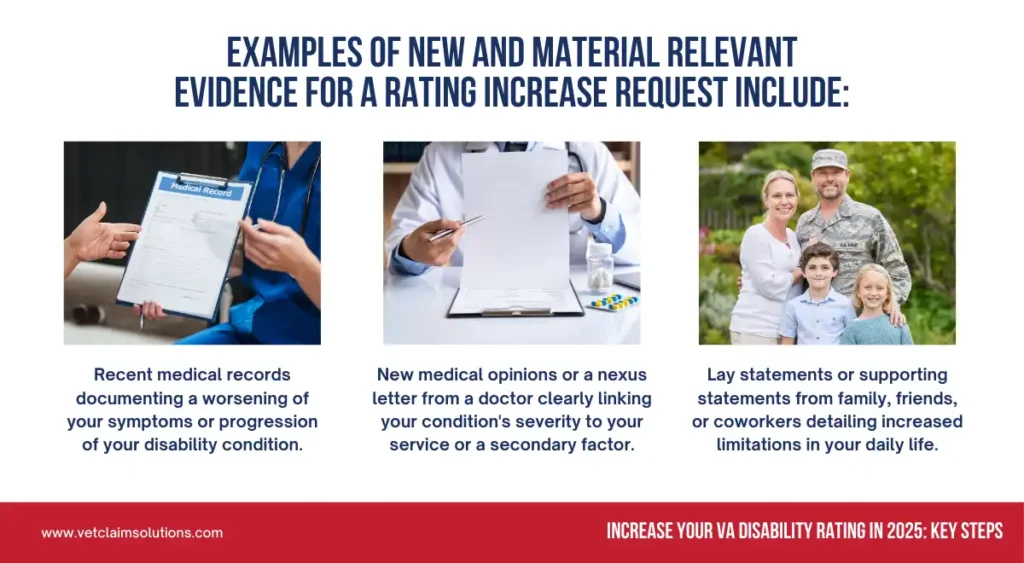
It is very important that any new evidence you submit directly addresses the reasons for the VA’s previous denial of your claim for a higher rating. A well-prepared supplemental claim with strong new evidence offers a solid opportunity for a more favorable outcome. This path is often used when a veteran’s condition worsened after a prior decision.
Understand the Appeals Process
If your va claim for an increased rating is denied, or if you disagree with the new rating level, you have the right to appeal the decision. The VA appeals process was modernized in 2019 with the Appeals Modernization Act (AMA), offering veterans several appeal options.
Under the AMA, you generally have three avenues for veterans’ appeals:
- Higher-Level Review (HLR): A more senior VA adjudicator will conduct a fresh review of your existing claim and evidence. No new evidence can be submitted with an HLR request. This is often a good first step if you believe there was an error in the initial decision.
- Supplemental Claim: This option allows you to submit new and relevant evidence that was not previously considered by the VA. This is the path taken if you have obtained new medical records or a nexus letter since the last decision.
- Appeal to the Board of Veterans’ Appeals (BVA): You can take your case directly to a Veterans Law Judge at the BVA. You can choose to submit more evidence, request a hearing, or have the BVA review the existing record.
Each of these appeal options has specific requirements and timelines. Carefully consider which path is best for your situation. Choosing the correct appeal option is crucial for success.

Avoiding Common Mistakes in Your Increase Request
Several common pitfalls can hinder a veteran’s attempt to secure a disability rating increase. Being aware of these can help you avoid delays and improve your chances of success. One frequent error is missing deadlines for submitting evidence or filing appeals; always note VA deadlines.
Another issue is not providing sufficient or specific medical evidence to demonstrate that your disability condition has worsened or its impact on your life has increased. Vague statements are less effective than concrete medical documentation and detailed personal accounts. Also, some veterans unintentionally downplay their symptoms during C&P exams or in their statements, which can lead to a rating that doesn’t accurately reflect their level of disability.
Failing to understand the specific criteria the VA uses to evaluate your particular disability condition can also lead to problems. Each disability has a rating schedule, and your evidence must align with the criteria for a higher rating level. Taking the time to prepare thoroughly and submit a complete VA form and all supporting documentation can make a substantial difference in the outcome of your va disability claim.
Keep Up with VA Policy Changes
VA policies, regulations, and the Schedule for Rating Disabilities can change. Staying informed about these updates can directly impact your strategy for seeking a disability rating increase.
Recent changes to watch for that might affect your va benefits include:
- Updates to the VA Schedule for Rating Disabilities (VASRD), which dictates rating percentages.
- Changes in how the VA evaluates specific conditions, such as mental health disorders or sleep apnea.
- Addition of new presumptive conditions, especially those related to toxic exposures like through the PACT Act. Your regional office can sometimes provide information.
Being aware of these policy shifts allows you to adapt your approach and potentially leverage new rules or presumptive conditions that could lead to a higher va disability rating. An old denial might be overcome if the law or regulations have changed favorably since the decision on your initial rating.
Maintain Open Communication with Your Healthcare Providers
Your healthcare providers are instrumental in documenting the severity and impact of your disabilities. Cultivating strong, open relationships with your doctors and specialists is beneficial. Be clear and comprehensive when describing how your service-connected conditions affect your health and daily functioning.
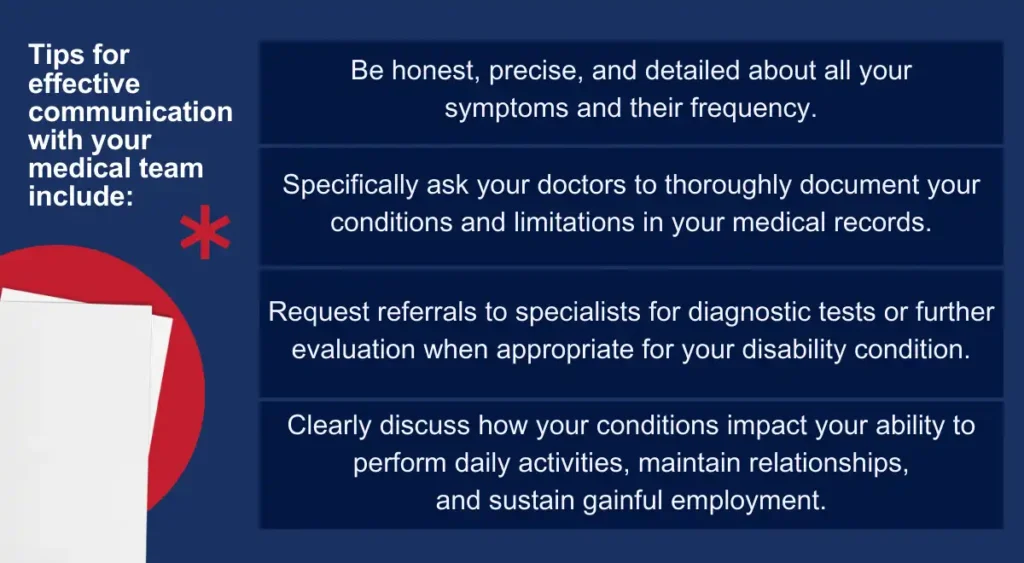
Good communication ensures that your medical evidence accurately reflects the true extent of your disabilities. This accurate documentation is vital for the VA to make a fair assessment of your claim for an increased rating and for achieving a favorable outcome. This is a key part of how to increase your va disability rating effectively.
Conclusion
Securing an increase to your VA disability rating in 2025 requires diligence, preparation, and an understanding of the VA claims process. By consistently gathering strong medical evidence, clearly articulating how your condition worsened, understanding options like secondary service connection or individual unemployability, and staying proactive with reevaluations and policy changes, you improve your prospects for a higher rating and increased va benefits.
The goal is to receive fair disability compensation for the impact your service-connected disabilities have on your life. Your persistence and a well-supported va claim are crucial elements for success.
Continue to advocate for yourself and the disability benefits you have earned through your service. With a strategic approach and comprehensive evidence, you can successfully work through the VA system to achieve the VA disability rating increase you deserve. This will help secure your financial stability and access to necessary care for your service-connected disabilities.


